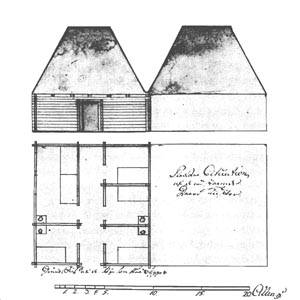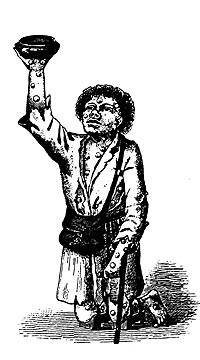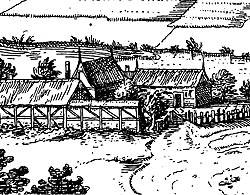
There are no known depictions
of a lunatic asylum other than the one
illustrated here, from Copenhagen in 1738.
A case from Elsinore in 1571 – where an accusation of witchcraft was caused by a mentally ill person
Willum Skriver was a newcomer in Elsinore and had difficulty being accepted in the town. The neighbours accused him of keeping itinerants in his house. When his niece became insane, he feared accusations of witchcraft. W. Skriver wanted to divert attention from his family and therefore raised an accusation of witchcraft against two self-employed women. The women already had a bad reputation and therefore his accusations resulted in a wealth of further accusations from neighbours and competitors, after which both women were convicted and burned at the stake.
Mass psychosis
Examples of mass psychoses are known from Thisted in 1696 and Salem, Massachusetts in 1692. In these cases some young girls felt themselves possessed and pointed out "witches". In Denmark and-Norway it seldom occurred that it was possessed persons that pointed out witches. In Scandinavia more often the people accused of witchcraft were those who were more knowledgeable than others or had "evil eyes"

A leper is begging.
Illustration on a tablet from
the Middle Ages
in
the National Museum.
Lunatic asylum for the uncontrollably mad
Lunatic asylums were detention facilities, primarily for dangerous insane persons. Lunatic asylums have probably existed since the Middle Ages, to begin with by means of private and local arrangements. They came to serve as detention centers for persons considered uncontrollably mad and incurably insane, until so-called curative asylums – the current psychiatric hospitals – were built in the 1800s. The earliest known lunatic asylum is mentioned in a mortgage from Ribe in 1454.
New legal provisions
From the making of the Danish Law of 1683 to the beginning of the 1800s, new legal provisions were introduced in Denmark which had the purpose of sorting out and separating the insane from the criminals. The intention was primarily to safeguard society by having a secure safekeeping of the insane. The less insane were still taken care of by the traditional welfare system of the time (family, local community and poor-law authorities). Only insane people who were considered dangerous or too difficult to handle were placed in lunatic asylums. Here they could stay locked up and isolated for many years or even decades.
Ordinance of July 29, 1709
- for the officers of the diocese and the bishops:
In this regulation the authorities took upon themselves the duty of the keeping of persons that were insane. But in the beginning they were slow to comply. In 1742 the higher authorities had to strongly emphasize to Dioceses all over the country that it was necessary to establish more asylums. There were continuing complaints from the Provinces that crazy and raving mad persons were running around free, and demands were that these persons had to be safely kept.

St. Jørgens Farm - St. Hans
St. Jørgens Farm - St. Hans
St. Jørgens Farm in Copenhagen was originally used for lepers. Later, when this terrible disease disappeared, the farm was mostly used for patients with infectious diseases, but also for keeping the uncontrollably mad. It was, in the late Middle Ages, known as the Pest House on account of its use as institution for infectious diseases. In 1632 St. Jørgens Farm was moved out of Copenhagen and at the same time 30 lunatic accommodations were added to it. After this it became known as St. Hans, an institution for the insane, plague victims and invalids. In 1768 it was all moved to Ladegaard in Copenhagen.
Finally in 1807, following an evacuation from the bombardment of Copenhagen, all patients were moved to Bidstrupgård near Roskilde now named St. Hans
St. Hans got its first Consultant Psychiatrist in 1816. In 1860 the last of the poor people were moved out of St. Hans and it became an institution for the mentally ill only.



